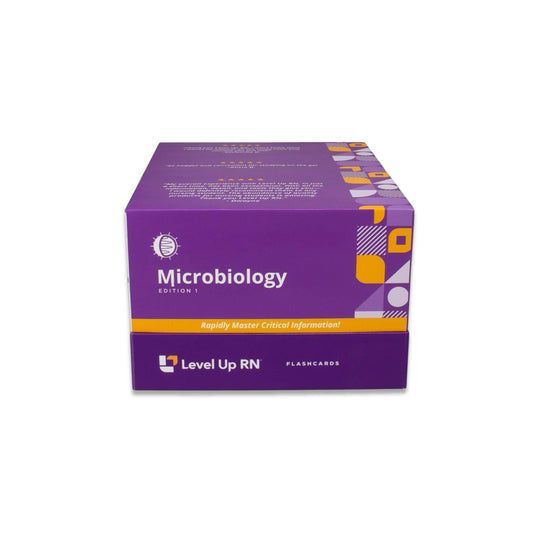Transcription; the steps involved in transcription, including initiation, elongation, and termination. Key differences in transcription between a prokaryotic cells and a eukaryotic cell; key processing steps that a primary transcript must undergo in a eukaryotic cell, including the addition of a 5' cap and poly-A tail, and RNA splicing.
Microbiology, part 34: Genetics - Transcription
Full Transcript: Microbiology, part 34: Genetics - Transcription
Full Transcript: Microbiology, part 34: Genetics - Transcription
Hi. I'm Cathy with Level Up RN. In this video, we will be discussing transcription. And at the end of the video, I'm going to give you guys a little quiz to test your knowledge of some of the key facts I'll be covering, so definitely stay tuned for that. And if you have our Level Up RN microbiology flashcards, go ahead and pull out your flashcards so you can follow along with me, and pay close attention to the bold red text on the back of the cards because those are the things that you are likely to be tested on in your micro class.
Transcription is the process of synthesizing messenger RNA, or mRNA, using the information encoded in DNA. This transcript can then be used to make a protein through the process of translation. And we will be covering the details of translation in a separate video. So let's first go through the steps involved in transcription in a prokaryotic cell, and then we will review key differences in transcription between a prokaryotic cell and a eukaryotic cell. Initiation of transcription begins at the promoter site on the DNA strand. RNA polymerase binds to the promoter site and then moves along reading the DNA template. It synthesizes a complementary RNA strand, adding new nucleotides in the 5' to 3' direction only.
As a reminder, guanine and cytosine are complementary base pairs. So if the DNA nucleotide contains guanine, then RNA polymerase will synthesize a nucleotide that contains cytosine and will add that onto the mRNA strand. And conversely, if the DNA nucleotide contains cytosine, then RNA polymerase will synthesize a nucleotide that contains guanine and add that onto the mRNA strand. Adenine and thymine are also complementary base pairs. However, thymine is replaced with uracil in RNA. So if a DNA nucleotide contains thymine, then RNA polymerase will synthesize a nucleotide that contains adenine and add that onto the mRNA strand. However, if the DNA nucleotide contains adenine, then RNA polymerase will synthesize a nucleotide that contains uracil and add that onto the mRNA strand. Once RNA polymerase reaches the terminator site on the DNA template strand, then transcription stops, and the mRNA molecule is released and can now be used to synthesize a protein.
There are some important differences in the transcription process between prokaryotic cells and eukaryotic cells. In prokaryotic cells, transcription occurs in the cytoplasm, whereas in eukaryotic cells, transcription occurs in the nucleus, and then the mRNA strand has to be moved to the cytoplasm to be translated. In addition, the mRNA strand in a eukaryotic cell must undergo several processing steps before it can be translated.
So let's go through those processing steps now. The mRNA strand synthesized by RNA polymerase in the nucleus of a eukaryotic cell is referred to as the primary transcript, which then undergoes processing. As part of this processing, a special nucleotide called a 5' cap is added to the 5' end of the transcript. This helps to prevent degradation of the transcript and also helps the ribosome bind to the mRNA molecule during translation. In addition, a poly(A) tail is added to the 3' end of the transcript. This poly(A) tail also helps to prevent degradation of the transcript and signals that the transcript is ready to be exported to the cytoplasm.
Another important step involved in processing of the RNA transcript in a eukaryotic cell is something called RNA splicing. So in a eukaryotic gene, there are sequences of DNA that encode for amino acids, which are used to make proteins. And those sequences are referred to as exons. And then DNA sequences that do not encode for amino acids are referred to as introns. During RNA splicing, a large RNA protein complex called a spliceosome removes segments of the RNA transcript that correspond to introns. And then the remaining segments that correspond to exons are combined.
And our cool chicken hint to help you remember the difference between introns and exons is to remember that exons are expressed and are not excised. One important thing I wanted to note is that during RNA splicing, alternative splicing can occur, which means that exons can be joined in different combinations. And the significance of this is that from a single DNA sequence, we can end up with multiple mRNA transcripts, which are then translated to create multiple protein products.
All right. It's quiz time, and I have four questions for you. Question number one, where does initiation of transcription begin on the DNA strand? The answer is, at the promoter site. Question number two, are new nucleotides added to the mRNA strand in the 5' to 3' direction or the 3' to 5' direction? The answer is, the 5' to 3' direction. Question number three, once RNA polymerase reaches the blank site on the DNA template strand, transcription stops and the mRNA molecule is released. The answer is, terminator. And question number four, during RNA splicing, are introns or exons removed from the RNA transcript? The answer is, introns.
Okay. That's it for this video. I hope it was helpful. Take care, and good luck with studying.
[BLOOPERS]
Then RNA polymerase will synthesize DNA template strands to the 3'. Oh, my goodness.


